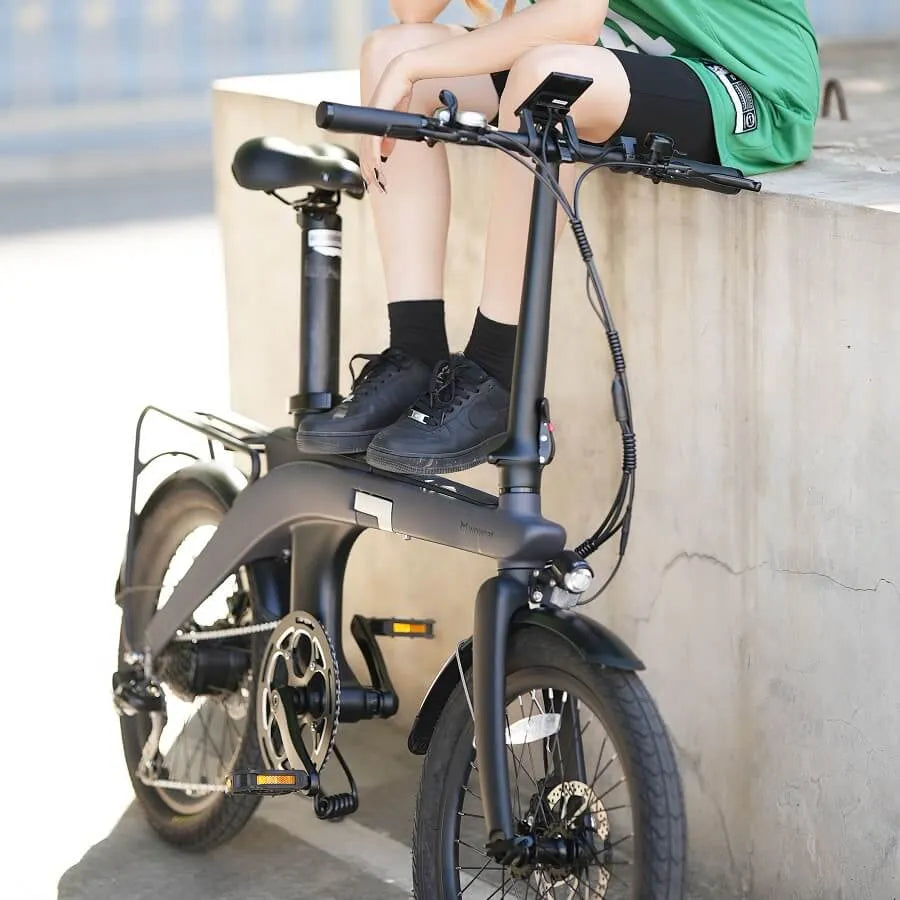In the realm of electric bikes, the choice between mechanical and hydraulic disc brakes is a pivotal decision that directly influences a rider's safety and overall cycling experience. As e-bikes continue to surge in popularity, understanding the distinctions between these braking systems becomes crucial for both seasoned cyclists and newcomers to the electrified two-wheel scene. Join us as we delve into the intricate world of disc brakes, exploring the nuances, advantages, and considerations that come with the mechanical and hydraulic variants when mounted on the powerhouse of an electric bike. Whether you're navigating urban streets or conquering rugged trails, the choice between these braking technologies could very well define your e-biking journey.
What are Mechanical Disc Brakes?
Mechanical disc brakes are a type of braking system used on bicycles, including electric bikes. Unlike traditional rim brakes, mechanical disc brakes operate by utilizing a cable to transmit force from the brake lever to the brake caliper, initiating the braking action. Here are the key components and features of mechanical disc brakes:
Brake Lever: The rider controls the braking system using a brake lever attached to the handlebars. When the lever is squeezed, the tension in the brake cable increases, activating the braking mechanism.
Brake Cable: The brake cable is a flexible metal cable that runs from the brake lever to the brake caliper. When the rider applies pressure to the brake lever, it pulls the cable, initiating the braking process.
Brake Caliper: The brake caliper is a component mounted on the frame or fork of the bike. It houses the brake pads and is responsible for squeezing them against the rotor to create friction and slow down the wheel.
Brake Pads: Mechanical disc brakes use brake pads made of materials like organic compounds or metal. These pads make contact with the rotor to generate friction, resulting in the deceleration of the wheel.
Rotor: The rotor is a disc-shaped component attached to the wheel hub. It rotates with the wheel and is situated between the brake pads. When the brake is applied, the caliper clamps the brake pads onto the rotor, creating the necessary friction for braking.

Advantages of Mechanical Disc Brakes
Ease of Maintenance: Mechanical disc brakes are generally easier to maintain and repair than hydraulic systems. Adjustments and cable replacements can be done with basic bike tools.
Cost: Mechanical disc brakes are often more affordable than their hydraulic counterparts, making them a budget-friendly option for cyclists.
Compatibility: Mechanical disc brakes are compatible with a wider range of brake levers and are easier to integrate into existing bike setups.
Field Repairs: In the event of a brake system failure, mechanical disc brakes can often be temporarily fixed with basic tools and adjustments, making them more suitable for on-the-go repairs.
Considerations:
Less Precise Control: Mechanical disc brakes may require more hand strength to achieve the same level of braking as hydraulic systems. Riders might find that they offer less precise control over braking force.
Cable Stretch and Adjustment: Over time, the brake cable in mechanical systems may experience stretching, leading to the need for periodic adjustments to maintain optimal brake performance.
Maintenance Frequency: While easier to maintain, mechanical disc brakes might require more frequent adjustments compared to hydraulic systems.
Mechanical disc brakes are a reliable braking solution suitable for various riding conditions. They are often favored by riders who prioritize ease of maintenance and affordability without compromising braking performance on their e-bikes.
What are Hydraulic Disc Brakes?
Hydraulic disc brakes are a sophisticated braking system used on bicycles, including electric bikes (e-bikes). Unlike mechanical disc brakes that rely on cables, hydraulic disc brakes employ hydraulic fluid to transmit force from the brake lever to the brake caliper, resulting in braking action. Here are the key components and features of hydraulic disc brakes:
Brake Lever: The rider controls the braking system using a hydraulic brake lever attached to the handlebars. When the lever is squeezed, it pressurizes the hydraulic fluid in the brake lines, initiating the braking process.
Hydraulic Brake Fluid: Instead of a cable, hydraulic disc brakes use a sealed system filled with hydraulic brake fluid. This non-compressible fluid transmits force from the brake lever to the brake caliper.
Brake Caliper: The brake caliper is a component mounted on the frame or fork of the bike. It houses pistons that are actuated by the hydraulic fluid pressure. The pistons, in turn, push the brake pads against the rotor to create friction and decelerate the wheel.
Brake Pads: Hydraulic disc brakes use brake pads, similar to those in mechanical systems, that make contact with the rotor to generate friction and facilitate braking.
Rotor: The rotor is a disc-shaped component attached to the wheel hub. It rotates with the wheel and is situated between the brake pads. When the brake is applied, the caliper's pistons press the brake pads onto the rotor, creating friction and initiating the braking process.

Advantages of Hydraulic Disc Brakes:
Better Modulation and Control: Hydraulic disc brakes offer superior modulation, providing more precise control over braking force. Riders can apply gradual or sudden braking with a light touch on the lever.
Increased Braking Power: Hydraulic systems generally provide higher braking power with less effort from the rider. This is especially beneficial for e-bikes, which may have added weight and require efficient braking.
Consistent Performance: Hydraulic disc brakes are less prone to cable stretch, ensuring consistent braking performance over time. This makes them reliable for various riding conditions.
Reduced Hand Fatigue: Hydraulic systems require less effort at the brake lever, reducing hand fatigue during long rides or extended braking periods.
Considerations:
Complex Maintenance: Hydraulic disc brakes may require more specialized knowledge and tools for maintenance and repairs. Bleeding the brake lines to remove air bubbles is a common maintenance task.
Higher Initial Cost: Hydraulic disc brakes are often more expensive than mechanical disc brakes, both in terms of the components themselves and potential maintenance costs.
Compatibility Issues: Hydraulic disc brakes may have compatibility issues with different brake levers and systems. Mixing and matching components from different manufacturers might require additional adjustments.
Hydraulic disc brakes are a premium braking solution favored by cyclists who prioritize top-notch performance, especially in demanding conditions. Their superior modulation and braking power make them an excellent choice for e-bikes where consistent and reliable braking is crucial.
What Is the Difference Between Mechanical Disc Brakes and Hydraulic Disc Brakes?
The primary differences between mechanical disc brakes and hydraulic disc brakes lie in the way they transmit force and the mechanisms used to initiate braking. Here's a breakdown of the distinctions between the two braking systems:
Actuation Mechanism:
Mechanical Disc Brakes: Mechanical disc brakes use a cable to transmit force from the brake lever to the brake caliper. When the rider squeezes the brake lever, the cable pulls the brake caliper's arms, initiating the braking action.
Hydraulic Disc Brakes: Hydraulic disc brakes use a sealed hydraulic system. Squeezing the brake lever pressurizes hydraulic fluid in the brake lines, which then activates the pistons in the brake caliper, pushing the brake pads against the rotor.
Braking Performance:
Mechanical Disc Brakes: Mechanical brakes may require more hand strength to achieve the same level of braking force as hydraulic brakes. They may also offer less precise modulation, making it challenging to control the amount of braking power.
Hydraulic Disc Brakes: Hydraulic brakes provide superior modulation, allowing riders to control the braking force more precisely. They typically require less effort at the brake lever and offer consistent braking performance.
Maintenance and Adjustments:
Mechanical Disc Brakes: Mechanical brakes are generally easier to maintain and adjust. Cable tension adjustments and cable replacements can be done with basic bike tools.
Hydraulic Disc Brakes: Hydraulic systems may require more specialized knowledge and tools for maintenance, especially when it comes to tasks like bleeding the brake lines to remove air bubbles. Regular maintenance is crucial for optimal performance.
Ease of Installation:
Mechanical Disc Brakes: Mechanical brakes are often easier to install and may be more forgiving for riders who want to perform basic maintenance and adjustments themselves.
Hydraulic Disc Brakes: Installing hydraulic disc brakes may be more complex, and improper installation can lead to issues such as brake fluid leaks. Professional installation is recommended.
Cost:
Mechanical Disc Brakes: Mechanical brakes are generally more budget-friendly upfront and may have lower maintenance costs. This makes them a cost-effective option for riders on a budget.
Hydraulic Disc Brakes: Hydraulic brakes tend to be more expensive initially, and the cost of maintenance, including brake fluid and potential bleeding kits, can be higher.
Weight:
Mechanical Disc Brakes: Mechanical systems are often lighter than hydraulic systems, making them a consideration for riders who prioritize minimizing overall bike weight.
Hydraulic Disc Brakes: Hydraulic systems, with their additional fluid-filled components, can be heavier than mechanical systems.
Which is Best for You?
The choice between mechanical and hydraulic disc brakes depends on various factors, including your riding preferences, budget, and willingness to perform maintenance tasks. Here are some considerations to help you determine which type of disc brakes might be best for you:
Choose Mechanical Disc Brakes If:
Budget is a Priority: Mechanical disc brakes are generally more affordable upfront and may have lower maintenance costs. If you're on a tight budget, mechanical brakes might be a cost-effective choice.
Ease of Maintenance: If you prefer a braking system that is easier to maintain and adjust yourself, mechanical disc brakes are more straightforward. They don't require specialized knowledge or tools for basic adjustments.
Simplicity and DIY Repairs: Mechanical brakes are more forgiving for riders who want to perform basic maintenance and repairs themselves. Adjusting cable tension and replacing cables can be done with common bike tools.
Weight Concerns: If you prioritize minimizing the overall weight of your bike, mechanical disc brakes are generally lighter than hydraulic systems.
Choose Hydraulic Disc Brakes If:
Braking Performance: If you prioritize superior braking performance and precise modulation, hydraulic disc brakes are the preferred choice. They offer better control and often require less effort at the brake lever.
Consistent Performance: Hydraulic systems are less prone to cable stretch, providing consistent braking performance over time. This can be particularly important for riders seeking reliable braking, especially on an e-bike with added weight.
Reduced Hand Fatigue: If you plan on long rides or extended periods of braking, hydraulic disc brakes are known for reducing hand fatigue. They require less effort at the brake lever.
Professional Installation: If you prefer having your bike serviced by a professional or want the assurance of a precise installation, hydraulic disc brakes may be the better choice. Improper installation can lead to issues like brake fluid leaks.
Consider Your Riding Style:
Casual Riding: If you primarily engage in casual rides and commuting, mechanical disc brakes may offer sufficient braking power and be a more economical choice.
Technical Riding or Downhill: For riders engaging in more technical trails, downhill riding, or e-bike applications where consistent and powerful braking is crucial, hydraulic disc brakes are often recommended.
DIY Enthusiast: If you enjoy performing your bike maintenance and adjustments and prioritize a simpler system, mechanical disc brakes may be a good fit.
Weight Conscious: If you are particularly conscious of your bike's weight and want to minimize it, especially for competitive or performance-oriented riding, mechanical disc brakes may be preferable.
Ultimately, the best choice depends on your individual preferences, riding style, and the specific requirements of your bike. If possible, test ride bikes equipped with each type of brake system to get a feel for their performance and decide which aligns better with your needs.











